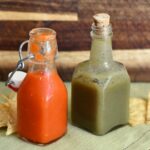Fermented Hot Sauce
This simple fermented hot sauce recipe is designed to help you create your own signature hot sauce flavor. Add fruit, vegetables, or spices. Make it as hot or not as you want!
- Prep Time: 15 minutes
- Total Time: 15 minutes
- Yield: 1/4 to 1/2 cup 1x
- Category: Condiment
- Method: Fermented
- Cuisine: Mexican
- Diet: Vegan
Ingredients
Units
Scale
- 3 1/2 cups of coarsely chopped vegetables and/or fruit
- 4 to 12 hot peppers, with the seeds left in (see section above for the different heat levels)
- 3 cloves of garlic
- 1 Tbsp salt (non-iodized)
- 2 Tbsp of water, as needed, to cover (chlorine-free)
Instructions
- Usually, hot sauce is made with a combination of sweet and hot peppers. However, it’s OK to use whatever flavors you want. If you’re new to DIY hot sauce, it is tempting to use just hot peppers, but it will be hotter than you expect. See the section above for a few of my favorite combinations.
- Finely chop all the vegetables in a food processor or blender. Add the salt and continue to pulse until it’s as smooth as possible.
- Scrape the hot sauce puree into a quart-sized (1L) jar for fermenting. Depending on the combination of vegetables, you may need to add a bit of water to keep everything under the liquid. To keep everything below the liquid for fermenting, use a zip-top bag filled with water as a weight. Generally, I don’t recommend using plastic bags for fermenting, but in this case, it’s the best option.
- Store the jar in a dark location for fermenting and let it ferment for 5-7 days.
- When you have finished fermenting, strain the pulp through a fine-mesh sieve, squeezing out all the liquid. Store the hot sauce in a jar for serving and discard the pulp (or see notes for a suggestion on how to reuse the pulp).
- If you want to add additional flavors like lime juice, vinegar, or sugar, add them at this point.
- Store your hot sauce in the fridge and use it within 1 month (for hot sauce). You can also freeze hot sauce to increase the storage time. I usually store my hot sauce in 1-cup jars. That way I can freeze it in small batches.
Notes
- The combination of hot peppers and salt will help prevent your hot sauce from going off. However, hot sauce is prone to kahm yeast. Kahm yeast isn’t an issue, just make sure it’s not mold.
- Don’t throw out leftover hot sauce pulp! It’s packed full of flavor, perfect for adding to chili or tortilla soup.
Nutrition
- Serving Size: 1 Tbsp
- Calories: 2
- Sugar: 0.3g
- Sodium: 97mg
- Fat: 0g
- Saturated Fat: 0g
- Carbohydrates: 0.5g
- Fiber: 0.1g
- Protein: 0.1g
- Cholesterol: 0g
Find it online: https://www.fermentingforfoodies.com/fermented-hot-sauce/
